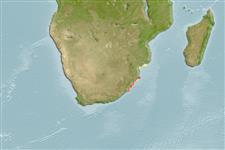Teleostei (teleosts) >
Blenniiformes (Blennies) >
Blenniidae (Combtooth blennies) > Salariinae
Etymology: Cirripectes: Latin, cirrus = curl fringe + Greek, pektos, -e, -on = made of several parts solidly united (Ref. 45335); heemstraorum: Named for Phil and Elaine Heemstra..
Environment: milieu / climate zone / depth range / distribution range
Ecology
Marine; reef-associated; depth range 1 - 17 m (Ref. 85156). Tropical
Western Indian Ocean: Africa.
Size / Weight / Age
Maturity: Lm ? range ? - ? cm
Max length : 4.9 cm SL male/unsexed; (Ref. 85156); 7.1 cm SL (female)
Short description
Identification keys | Morphology | Morphometrics
Dorsal spines (total): 12; Dorsal soft rays (total): 16; Anal spines: 2; Anal soft rays: 17; Vertebrae: 32. This species is distinguished by the following set of characters: nape with greatly expanded black nuchal flap on both sides; 10-13 independently based cirri distributed between the nuchal flaps; dorsal fin entire; 5-6 total supraorbital cirri, 6-8 total nasal cirri; males with small dark spots posteriorly on body coalescing into short black stripes on caudal peduncle; females with brilliant yellow caudal fin (pale when preserved; contrasting sharply with dark brown body); in males the outer half of caudal fin is brilliant yellow (Ref. 85156).
Facultative air-breathing in the genus (Ref. 126274); Oviparous. Eggs are demersal and adhesive (Ref. 205), and are attached to the substrate via a filamentous, adhesive pad or pedestal (Ref. 94114). Larvae are planktonic, often found in shallow, coastal waters (Ref. 94114).
Life cycle and mating behavior
Maturities | Reproduction | Spawnings | Egg(s) | Fecundities | Larvae
Williams, J.T., 2010. A new species of blenny, Cirripectes heemstraorum, from Cape Vidal, South Africa (Family Blenniidae). Smithiana Bull. (12):3-8. (Ref. 85156)
IUCN Red List Status (Ref. 130435)
Threat to humans
Harmless
Human uses
Tools
Special reports
Download XML
Internet sources
Estimates based on models
Preferred temperature (Ref.
123201): 23.6 - 24.6, mean 24.2 °C (based on 16 cells).
Phylogenetic diversity index (Ref.
82804): PD
50 = 0.5000 [Uniqueness, from 0.5 = low to 2.0 = high].
Bayesian length-weight: a=0.01072 (0.00480 - 0.02393), b=3.01 (2.82 - 3.20), in cm total length, based on LWR estimates for this (Sub)family-body shape (Ref.
93245).
Fishing Vulnerability (Ref.
59153): Low vulnerability (10 of 100).
